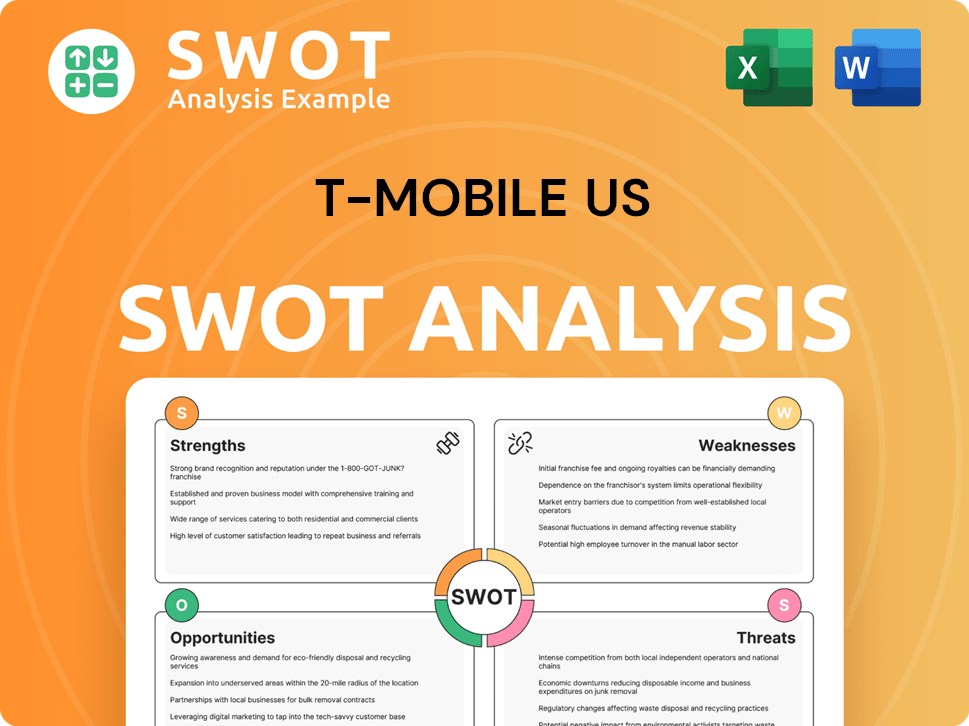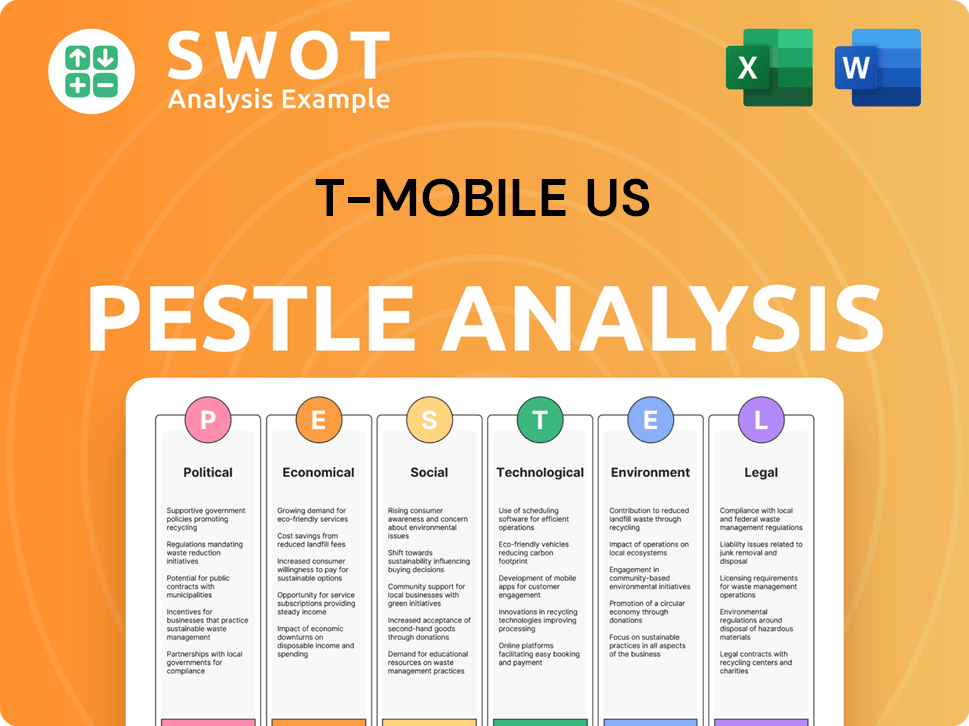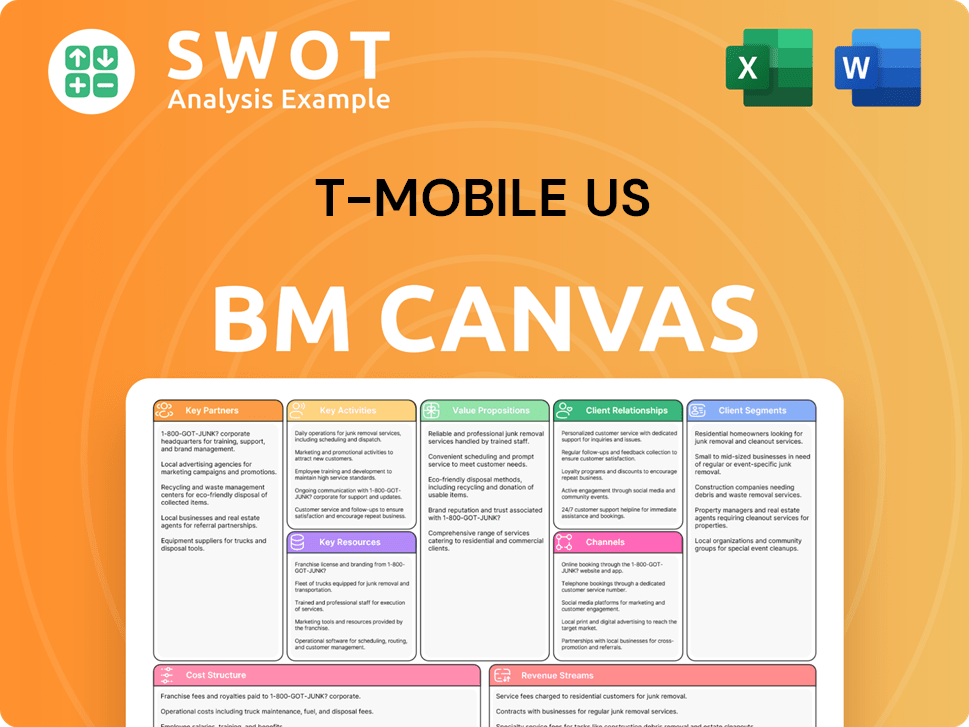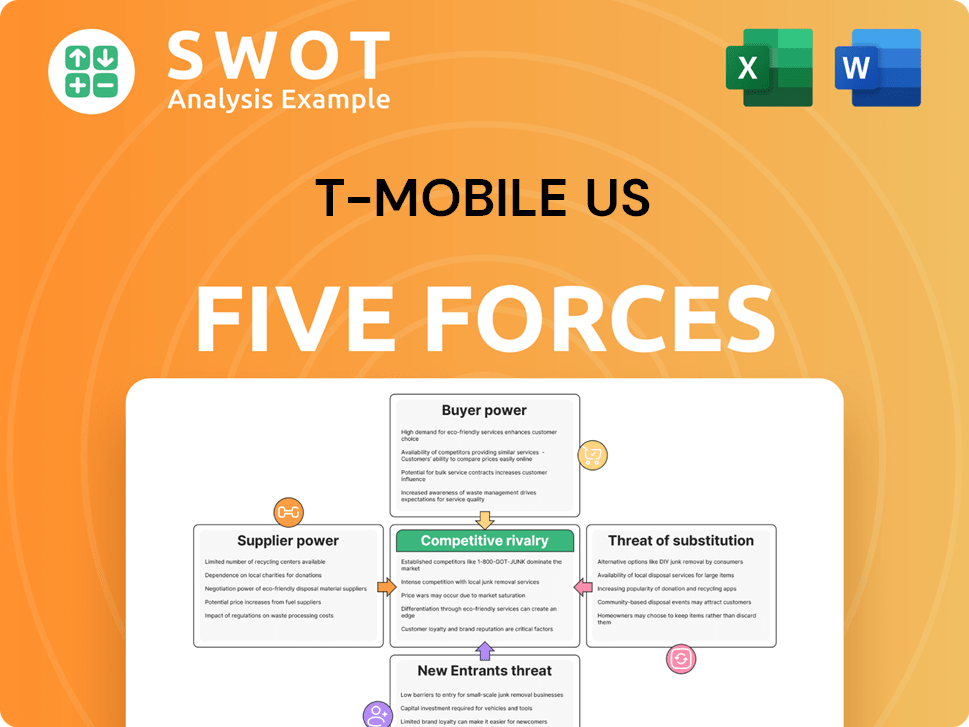T-Mobile US Bundle
Who Buys T-Mobile? Unveiling the Customer Behind the Brand
In the fast-paced world of telecommunications, understanding your customer is paramount. T-Mobile US, a leader in the wireless industry, has consistently challenged the status quo, but who exactly are the people fueling its success? This analysis dives deep into the T-Mobile US SWOT Analysis, exploring the customer demographics and target market that drive T-Mobile's strategic decisions.

This exploration will dissect the T-Mobile US customer profile, examining factors like age, income levels, geographic distribution, and even customer interests. We'll uncover how T-Mobile segments its T-Mobile target market, including millennials and Gen Z, and how these insights inform its customer acquisition and retention strategies. A thorough T-Mobile market analysis will reveal the dynamics of its user base and the impact of competitor customer demographics.
Who Are T-Mobile US’s Main Customers?
Understanding the primary customer segments is crucial for a comprehensive market analysis of T-Mobile US. The company strategically divides its focus between consumers (B2C) and businesses (B2B), each with distinct needs and characteristics. This segmentation allows for tailored marketing efforts and product offerings, enhancing customer acquisition and retention.
Within the B2C segment, T-Mobile's 'Un-carrier' approach has historically resonated with value-conscious and tech-savvy customers, including millennials and Gen Z. The acquisition of Sprint expanded its reach to include a broader range of income levels and geographical distributions. Furthermore, T-Mobile caters to budget-conscious consumers through brands like Metro by T-Mobile and provides free wireless services to eligible low-income individuals via Assurance Wireless.
The B2B segment, though smaller, focuses on providing wireless solutions to small, medium, and large enterprises. This includes customized plans and IoT solutions, catering to specific communication and connectivity needs. T-Mobile's ability to attract customers who prioritize both value and superior network performance is a key factor in its sustained growth.
T-Mobile's customer base is diverse, spanning various age groups, income levels, and geographic locations. The company's marketing strategies are designed to appeal to a wide range of customers, from budget-conscious consumers to those seeking premium services. The acquisition of Sprint has significantly broadened the customer base, leading to a more diverse demographic profile.
The primary customer segments include consumers and businesses. Within the consumer segment, there's a focus on value-driven customers, tech enthusiasts, and those seeking prepaid options. The B2B segment targets small, medium, and large enterprises with tailored wireless solutions. These segments are crucial for understanding T-Mobile's overall market position.
T-Mobile's customer base includes individuals from various income levels, reflecting the diverse pricing options and service offerings. The geographic distribution of customers is widespread, with a significant presence in urban and suburban areas. The expansion of its 5G network has also allowed T-Mobile to reach customers in more rural areas.
T-Mobile employs various customer acquisition strategies, including competitive pricing, attractive promotions, and innovative service offerings. Customer retention is supported by strong network performance, excellent customer service, and loyalty programs. These strategies are crucial for sustaining growth and maintaining market share.
In Q4 2023, T-Mobile reported 1.3 million postpaid net account additions, showcasing strong growth. The total postpaid net customer additions for 2023 reached 5.7 million, demonstrating the company's ability to attract and retain customers. These figures highlight the effectiveness of T-Mobile's customer acquisition and retention strategies.
- T-Mobile's focus on 5G network expansion continues to attract customers.
- The company's 'Un-carrier' strategy has historically appealed to younger demographics.
- Metro by T-Mobile targets budget-conscious consumers.
- Assurance Wireless provides free wireless service to eligible low-income individuals.
T-Mobile US SWOT Analysis
- Complete SWOT Breakdown
- Fully Customizable
- Editable in Excel & Word
- Professional Formatting
- Investor-Ready Format

What Do T-Mobile US’s Customers Want?
Understanding the customer needs and preferences is crucial for the success of any business, and for T-Mobile US, this involves a deep dive into what drives its diverse customer base. The company's approach, often highlighted by its 'Un-carrier' initiatives, focuses on providing value, flexibility, and reliable connectivity. This strategy directly addresses the needs of customers seeking alternatives to traditional carrier constraints, such as hidden fees and restrictive contracts.
Customer purchasing behavior at T-Mobile is significantly influenced by competitive pricing, comprehensive network coverage, and attractive device financing options. The demand for robust 5G connectivity for streaming, gaming, and remote work is also a major driver, with customers increasingly prioritizing high-speed data plans. T-Mobile's focus on these areas helps it to cater to a wide range of customer preferences, ensuring its offerings remain appealing in a competitive market.
The T-Mobile US customer profile is shaped by a variety of factors, including the desire for seamless communication and internet access for daily life and work. Customer feedback plays a critical role in product development, influencing features like Scam Shield for call protection and enhanced international roaming options. This customer-centric approach, combined with continuous network upgrades, helps to address common pain points and build customer loyalty.
Customers prioritize network performance, with a focus on speed and reliability. T-Mobile's 5G network now covers 330 million people with its Extended Range 5G, and 300 million people with its Ultra Capacity 5G.
Customer service quality is a key decision-making criterion. T-Mobile has invested in improving customer support channels to enhance satisfaction and address issues promptly.
The availability of desired devices, along with attractive financing options, influences purchasing decisions. T-Mobile offers a wide range of devices to cater to different customer needs and preferences.
Loyalty is built on consistent network reliability, competitive pricing, and value-added services. Streaming perks and international roaming benefits are key differentiators.
Psychological drivers include a sense of liberation from traditional carrier constraints. T-Mobile's 'Un-carrier' approach appeals to customers seeking freedom and transparency.
Practical drivers involve the need for seamless communication and internet access. T-Mobile addresses common pain points through continuous network upgrades and innovative features.
T-Mobile's customer acquisition strategies and retention tactics are tailored to meet specific needs. The company uses a variety of methods, including targeted marketing and continuous network improvements, to attract and retain customers. For example, T-Mobile's focus on 5G Ultra Capacity has been a key selling point, with the network now covering a significant portion of the U.S. population. For a broader understanding of T-Mobile's journey and milestones, you can read about it in the Brief History of T-Mobile US.
- Targeted Marketing: T-Mobile tailors its marketing to specific segments, highlighting affordability for Metro by T-Mobile users and emphasizing network superiority and innovation for its flagship brand.
- Network Enhancements: Continuous network upgrades address common pain points like dropped calls and slow data speeds, improving customer satisfaction.
- Value-Added Services: Offering streaming perks and international roaming benefits adds value and encourages customer loyalty.
- Customer Feedback: Utilizing customer feedback through social media and direct interactions to influence product development, such as features like Scam Shield.
T-Mobile US PESTLE Analysis
- Covers All 6 PESTLE Categories
- No Research Needed – Save Hours of Work
- Built by Experts, Trusted by Consultants
- Instant Download, Ready to Use
- 100% Editable, Fully Customizable

Where does T-Mobile US operate?
The geographical market presence of T-Mobile US is primarily focused on the United States, encompassing all states, along with Puerto Rico and the U.S. Virgin Islands. This extensive coverage allows the company to serve a vast and diverse customer base across various regions. T-Mobile's strategy involves a blend of broad coverage and targeted expansions to meet the specific needs of different areas.
T-Mobile holds a significant market share across the U.S., with a strong presence in major metropolitan areas. These areas, with their high population densities, support a larger number of subscribers. However, the company is also actively expanding into rural and underserved areas. This expansion is driven by the aggressive rollout of its 5G network, aiming to bridge the digital divide and provide high-speed internet access to more Americans.
By the end of 2023, T-Mobile's Extended Range 5G covered 330 million people, and Ultra Capacity 5G reached 300 million people. This widespread coverage demonstrates T-Mobile's commitment to providing its services across diverse geographical landscapes. The company's approach includes localizing its offerings to meet regional needs, such as enhancing capacity in densely populated cities and expanding coverage in remote areas.
T-Mobile's customer demographics vary significantly across different regions. Urban customers often prioritize speed and capacity, while rural customers may value coverage and reliability more. This necessitates a tailored approach to network deployment and service offerings. Understanding these differences is crucial for effective T-Mobile market analysis.
Marketing efforts are also localized to resonate with regional preferences. This includes regional advertising campaigns and community engagement initiatives. These localized strategies help T-Mobile build stronger relationships with its customers and enhance its brand presence in specific geographical areas. This is a key part of T-Mobile customer acquisition strategies.
T-Mobile's strategic expansion into fixed wireless access (FWA) further strengthens its geographical market presence. FWA is particularly beneficial in areas where traditional broadband options are limited. In 2023, T-Mobile added 1.3 million FWA net customers, bringing its total FWA customer count to 4.8 million. This demonstrates successful penetration into diverse geographical markets beyond mobile services.
Understanding the T-Mobile US competitor customer demographics is crucial for maintaining a competitive edge. Analyzing the geographical distribution of competitors' customer bases helps T-Mobile identify opportunities for growth and areas where it can improve its service offerings. This analysis informs T-Mobile customer retention tactics.
T-Mobile's geographical market strategy focuses on comprehensive coverage and targeted expansions, catering to diverse customer needs across the U.S. This approach includes localized marketing, network deployments, and the strategic use of FWA. The company continues to invest in its 5G network to enhance coverage and capacity, ensuring it can serve a wide range of customers. For more insights, explore the Revenue Streams & Business Model of T-Mobile US.
- Extensive U.S. Coverage: T-Mobile serves the entire U.S., including Puerto Rico and the U.S. Virgin Islands.
- 5G Expansion: Significant investment in 5G to reach 330 million people with Extended Range 5G and 300 million with Ultra Capacity 5G by the end of 2023.
- Localized Strategies: Tailoring network deployments and marketing efforts to meet regional needs.
- FWA Growth: 4.8 million FWA customers by the end of 2023, with 1.3 million net additions in that year.
T-Mobile US Business Model Canvas
- Complete 9-Block Business Model Canvas
- Effortlessly Communicate Your Business Strategy
- Investor-Ready BMC Format
- 100% Editable and Customizable
- Clear and Structured Layout

How Does T-Mobile US Win & Keep Customers?
T-Mobile US employs a multifaceted approach to customer acquisition and retention, heavily leveraging its 'Un-carrier' strategy. This strategy focuses on transparent pricing, no annual contracts, and offering value-added services to attract new customers. Marketing efforts span digital platforms, traditional media, and influencer partnerships to reach a broad audience. The company's customer acquisition strategies are designed to appeal to diverse segments within its target market.
The company's customer acquisition strategies are designed to appeal to diverse segments within its target market. Sales tactics include promotional offers for new devices and service plans, often bundled with other services. Loyalty programs, such as T-Mobile Tuesdays, provide weekly deals and discounts, enhancing customer value. Personalized experiences, facilitated through CRM systems and data analytics, enable targeted marketing and tailored customer service. T-Mobile's commitment to expanding its 5G network and Fixed Wireless Access (FWA) also serves as an acquisition strategy, attracting customers seeking high-speed internet alternatives.
After-sales service is a critical retention tool, with T-Mobile investing in customer support channels and self-service options. Retention is also bolstered by continuously improving network quality and offering competitive upgrades, aiming to increase customer lifetime value and reduce churn rate. In 2023, T-Mobile achieved 5.7 million postpaid net customer additions, demonstrating the effectiveness of its acquisition strategies. Understanding the Marketing Strategy of T-Mobile US provides further insights into these efforts.
T-Mobile utilizes a mix of digital and traditional marketing channels. This includes social media, search engine marketing, online advertising, television, and radio. Influencer partnerships are also a key component.
Aggressive promotional offers are frequently used to attract new customers. These often include deals on new devices and service plans, sometimes bundled with other services.
T-Mobile Tuesdays offers weekly deals and discounts. Free Netflix subscriptions on certain plans add value. These perks enhance customer loyalty.
CRM systems and data analytics are used to personalize interactions. This allows for targeted marketing campaigns and tailored customer service to improve customer retention tactics.
Expanding the 5G network and offering Fixed Wireless Access (FWA) are key strategies. This attracts customers seeking high-speed internet alternatives, thus expanding the T-Mobile user base.
- Focus on network quality and coverage.
- Offers competitive upgrades.
- Aims to increase customer lifetime value.
- Reduces customer churn rate.
T-Mobile US Porter's Five Forces Analysis
- Covers All 5 Competitive Forces in Detail
- Structured for Consultants, Students, and Founders
- 100% Editable in Microsoft Word & Excel
- Instant Digital Download – Use Immediately
- Compatible with Mac & PC – Fully Unlocked

Related Blogs
- What are Mission Vision & Core Values of T-Mobile US Company?
- What is Competitive Landscape of T-Mobile US Company?
- What is Growth Strategy and Future Prospects of T-Mobile US Company?
- How Does T-Mobile US Company Work?
- What is Sales and Marketing Strategy of T-Mobile US Company?
- What is Brief History of T-Mobile US Company?
- Who Owns T-Mobile US Company?
Disclaimer
All information, articles, and product details provided on this website are for general informational and educational purposes only. We do not claim any ownership over, nor do we intend to infringe upon, any trademarks, copyrights, logos, brand names, or other intellectual property mentioned or depicted on this site. Such intellectual property remains the property of its respective owners, and any references here are made solely for identification or informational purposes, without implying any affiliation, endorsement, or partnership.
We make no representations or warranties, express or implied, regarding the accuracy, completeness, or suitability of any content or products presented. Nothing on this website should be construed as legal, tax, investment, financial, medical, or other professional advice. In addition, no part of this site—including articles or product references—constitutes a solicitation, recommendation, endorsement, advertisement, or offer to buy or sell any securities, franchises, or other financial instruments, particularly in jurisdictions where such activity would be unlawful.
All content is of a general nature and may not address the specific circumstances of any individual or entity. It is not a substitute for professional advice or services. Any actions you take based on the information provided here are strictly at your own risk. You accept full responsibility for any decisions or outcomes arising from your use of this website and agree to release us from any liability in connection with your use of, or reliance upon, the content or products found herein.